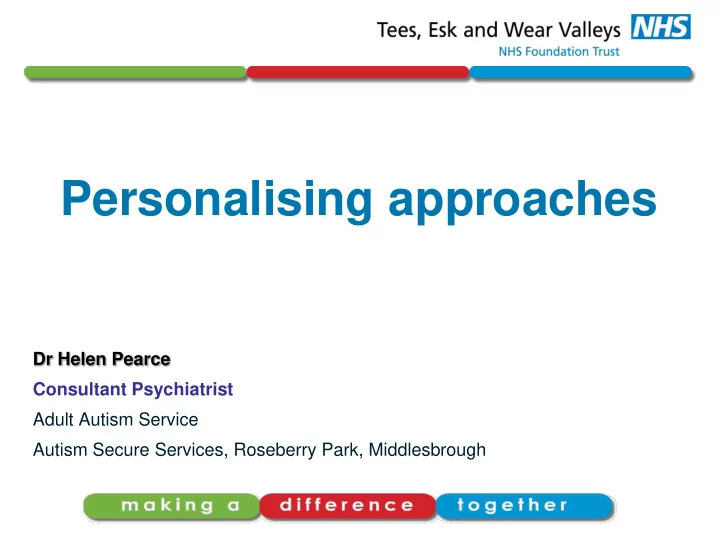

Personalising approaches Dr Helen Pearce Consultant Psychiatrist Adult Autism Service Autism Secure Services, Roseberry Park, Middlesbrough
Complexity ... … consisting of interconnected or interwoven parts … composed of two or more units … a whole that comprehends a number of intricate parts, especially one with interconnected or mutually related parts
What do people mean? Exhibiting challenging behaviour Complaining Not responding to intervention Not responding to treatments Not fitting with available services ‘Co - Morbidity’ Not ‘improving’
… that has not been connected or managed as a whole? Comprehensive understanding Comprehensive assessment Understanding the person at the centre Understanding the person in context
Evolving language … Challenging Behaviour Behaviours that challenge Challenging Behaviour Pathway Positive approached to supporting people whose behaviour is described as challenging policy Positive Behaviour Support Pathway
‘Once you have met one person with autism, you have met one person with autism.’ 6
The focus The individual - The presentation Understanding the purpose and function of a presentation Understanding the distress ‘Tuning in’ Professional curiosity
The focus The individual - The presentation Understanding the purpose and function of a presentation Understanding the distress ‘Tuning in’ Professional curiosity
BEHAVIOURAL FORMULATION Who x is and why they might be vulnerable? (Predisposing factors) Developmental history Learning disability Mental health difficulties Attachment Communication needs Physical health needs Why now? (Precipitating factors) Significant events…social / within environment / in treatment…. Setting Events/ Antecedents & Triggers (Perpetuating) What’s the function of Internal & External factors the behaviour? What things in the physical environment that might make behaviour more likely? Tangible, internal Are there certain environments that the behaviour is more likely to occur in? stimulation, attention, Is the behaviour more likely to occur around certain people? escape Does the behaviour tend to occur when tasks are too easy/ hard? What was the person Communication needs? trying to communicate? What could be going on internally? (Tiredness, hunger etc) Why couldn’t they do so in a different way? Protective Perpetuating Behaviour that Challenges What reduces the likelihood? What are the consequences for X? What are the exceptions to the rule? What are the consequences for others? Type, onset & history, things already tried, What are X’s strengths? What increases likelihood? Freq, duration & severity What things are important to X? 9 AROUSAL CYCLE
Predisposing factors Who he or she is and why they might be vulnerable? Developmental history Learning disability Mental health difficulties Attachment Communication needs Physical health needs
Precipitating factors Why now? Significant events… social within environment in treatment
Perpetuating factors Setting Events/ Antecedents & Triggers Internal & External factors What things in the physical environment that might make behaviour more likely? Are there certain environments that the behaviour is more likely to occur in?
Perpetuating factors ctd … Is the behaviour more likely to occur around certain people? Does the behaviour tend to occur when tasks are too easy/ hard? Communication needs? What could be going on internally? (Tiredness, hunger etc)
Perpetuating factors What are the consequences for him or her? What are the consequences for others? What increases likelihood?
Protective factors What reduces the likelihood? What are the exceptions to the rule? What are his or her strengths? What things are important to him/her?
Function What’s the function of the behaviour/presentation? Tangible, internal stimulation, ‘ attention’, escape What was the person trying to communicate? Why couldn’t they do so in a different way?
Emotional Arousal / Assault Cycle (Based on Kaplan and Wheeler 1983) Aggressive / Challenging / Violent Behaviour Escalation ( Potential Additional Phase Trigger Post-Crisis Assaults) Crisis (B) Phase Depression Phase (A) Phase (C) (E) Recovery Phase (D) Approximately 90 mins to fully recover. 17
Marty Anthony Tim
The Approach Multi-disciplinary Developmental perspective Formulation and Reformulation Within the day to day working of professionals Practical
Understanding Autism Assessment of Autism ADI/ 3DI/ DISCO/ Detailed Developmental History Observational Assessment Cognitive Assessment Communication Assessment Sensory Assessment 20
Individualised approach Autism PDA Ability vs Intellectual Disability ‘IQ’ Attachment Mental Illness Personality 21
The Individual Understanding autism Observations Use of tools Assessment tools Risk assessment tools Understanding the impact on presentation Understanding the person 22
Broader Assessment Assessment of Psychosis/ Mood/ Anxiety Attachment assessment Risk Assessment Tools IPDE/ Other assessment of Personality Attachment assessment Other specific Tools Flexibility of thought in the professional 23
Understanding the Impact on Presentation Interplay of a range of assessments Trajectory of Difficulties Formulation and reformulation Level of insight Ongoing Assessment 24
25
Autism Secure Services Low Secure Medium Secure Dr Helen Pearce Roseberry Park Tees, Esk and Wear Valleys NHS Foundation Trust h.pearce@nhs.net
Recommend
More recommend